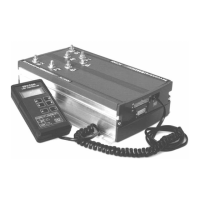22
nd
October 2004 SC2000 Manual – 177/52301 Rev G Page 39
12 POWER CIRCUIT DESCRIPTIONS
The main switching element of the SC2000 consists of a bank of power Mosfet transistors
connected in parallel. These are switched at high frequency (15.7khz) to give silent operation.
Switching speeds have been optimised to minimise switching losses.
Fast-recovery Freewheel diodes, also connected in parallel but arranged to share current, are
used to maintain circulating current around the motor when the main Mosfets are turned off.
Both the Mosfets and Freewheel diodes have their temperatures monitored. The software will
cutback motor current to prevent either thermal stress, or operation outside their safe
operating areas.
Electrolytic capacitors are fitted internally between B+ve and B-ve to maintain constant
current in the battery leads and to keep a constant battery voltage across the controller.
In Traction power frames a Plug Diode is internally connected across the motor armature to
limit the generated voltage during plugging so that controlled braking can be achieved. This
diode is not necessary for Pump motor controllers.
On traction controllers, Regen is achieved by adding an extra single pole change over
contactor and an optional regen diode which connects the top of the motor armature to B-ve
during braking, to allow circulating generated current to flow round the motor loop after the
direction contactors have been reversed and the motor excited. The generated armature
voltage charges the motor field with current when the MOSFETs are on. When they are off,
this current flows through the freewheel diodes back into the battery. This has the effect of
returning a small amount of energy back to the battery and minimising heat dissipation in the
motor during braking.
A current shunt is connected in series with the motor armature to monitor motor currents,
during all operations including drive, regen and plug braking modes.
On traction controllers the direction contactors should be used to switch the armature. A line
contactor can be used to offer reverse battery connection protection, minimise any battery
connector arcing when powering up, and to give a mechanical break in pump controller
systems. The line contactor is optional.
On Traction dual motor non proportional controllers, an extra set of direction contactors are
required to switch the second motor’s armature to be able to offer direction control, inner
motor drop out, and inner motor reversal during cornering. A balancing contactor connected
between the two armatures is usually necessary to prevent circulating currents in braking.
Traction dual motor proportional controllers also require an extra set of direction contactors
for direction control, although two independent choppers are utilised to provide true
proportional control during cornering. No balancing contactor is required for proportional
systems.
Bypass operation is possible on both traction and pump systems to short out the main Mosfet
devices for maximum efficiency and high speed or high current operation. Field Weakening
operation is also possible on both traction and pump controllers by controlling a contactor to
switch in resistor in parallel with the motor field. An output for controlling a power steer
contactor is also provided.

